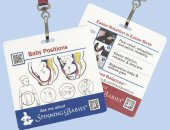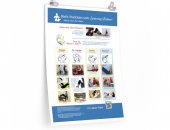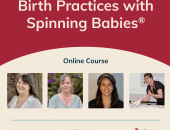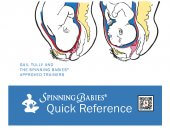Spinning Babies® 2021 Bibliography / General References helpful in discussion points for our approach.
Here is research complementing Spinning Babies.® (More coming) These studies support the approach though they were not research based on the approach. If more information is wanted on why or how safe it is that we do what we do, these studies give credence. Some of the conclusions are not in sync with our conclusions, but the data shows important information about our topics of discussion.
Blanc-Petitjean, P., Le Ray, C., Lepleux, F., De La Calle, A., Dreyfus, M., & Chantry, A. A. (2018). Factors affecting rotation of occiput posterior position during the first stage of labor. Journal of gynecology obstetrics and human reproduction, 47(3), 119-125.
Bellussi, F., Livi, A., Cataneo, I., Salsi, G., Lenzi, J., & Pilu, G. (2020). Sonographic diagnosis of fetal head deflexion and the risk of cesarean delivery. American Journal of Obstetrics & Gynecology MFM, 2(4), 100217.
Borrell, Ulf, Fernstrom, Ingmar. “Internal Anterior Rotation of the Foetal Head; a Contribution to Its Explanation.” Acta Obstetricia Et Gynecologica Scandinavica 38 (1959): 109. Print.
Borell, Ulf, and Ingmar Fernström. “The Movements at the Sacro-Iliac Joints and their Importance to Changes in the Pelvic Dimensions During Parturition.” Acta obstetricia et gynecologica Scandinavica 36.1 (1957): 42-57.
Broberg, J. C., & Caughey, A. B. (2021). A randomized controlled trial of prophylactic early manual rotation of the occiput posterior fetus at the beginning of the second stage vs expectant management. American journal of obstetrics & gynecology MFM, 3(2), 100327.
Bueno Lopez, V., Fuentelsaz Gallego, C., Casellas Caro, M., Falgueras Serrano, A. M., Crespo–Berros, S., Silvano-Cocinero, A. M., … &- Terré- -Rull, C. (2018). Efficiency of the modified Sims maternal position in the rotation of persistent occiput posterior position during labor: A randomized clinical trial. Birth.
Calais-Germain, Blandine. The Female Pelvis: Anatomy & Exercises 2003
Choi, Sk, et al. Sonographic assessment of fetal occiput position during labor for the prediction of labor dystocia and perinatal outcomes. J Matern Fetal Neonatal Med. (2016). http://www.ncbi.nlm.nih.gov/m/pubmed/26948718/
Dall’Asta, A., Rizzo, G., Masturzo, B., Eggebo, T., Flacco, M. E., Frusca, T., & Ghi, T. (2021). 480 Intrapartum sonographic features of cephalopelvic disproportion in non-occiput posterior fetuses: prospective multicenter study. American Journal of Obstetrics & Gynecology, 224(2), S305-S306.
Elmore, C., McBroom, K., & Ellis, J. (2020). Digital and Manual Rotation of the Persistent Occiput Posterior Fetus. Journal of midwifery & women’s health, 65(3), 387-394.
Fothergill WE. Walcher’s Position In Obstetrics. British Medical Journal 1898;1(1931):53.
Ghi, T., Angeli, L., & Frusca, T. (2021). Fetal Head Rotation in Labor: Intrapartum Assessment at 2D and 3D Ultrasound. In Intrapartum Ultrasonography for Labor Management(pp. 275-283). Springer, Cham.
Gimovsky, A. C. (2021). The Role of Intrapartum Sonography in Persistent Occiput Posterior Position and Prolonged Labor. In Intrapartum Ultrasonography for Labor Management(pp. 183-191). Springer, Cham.
Guerby, P., Allouche, M., Simon-Toulza, C., Vayssiere, C., Parant, O., & Vidal, F. (2018). Management of persistent occiput posterior position: a substantial role of instrumental rotation in the setting of failed manual rotation. The Journal of Maternal-Fetal & Neonatal Medicine, 31(1), 80-86.
Hofmeyr, G. J., & Singata-Madliki, M. (2020). The second stage of labor. Best Practice & Research Clinical Obstetrics & Gynaecology, 67, 53-64.
Lieberman, E., Davidson, K., Lee-Parritz, A., & Shearer, E. (2005). Changes in fetal position during labor and their association with epidural analgesia. Obstetrics & Gynecology, 105(5), 974-982.
Malai, S., Pichaiyongwongdee, S., & Sakulsriprasert, P. (2015). Immediate Effect of Hold-Relax Stretching of Iliopsoas Muscle on Transversus Abdominis Muscle Activation in Chronic Non-Specific Low Back Pain with Lumbar Hyperlordosis.
Mercier, R. J., & Kwan, M. (2018). Impact of peanut ball device on the duration of active labor: a randomized control trial. American journal of perinatology, 35(10), 1006-1011.
Nakao, S. et al. (2019) Chronic Effects of a Static Stretching Program on Hamstring Strength. The Journal of Strength & Conditioning Research
Oleksy, Ł., Mika, A., Kielnar, R., Grzegorczyk, J., Marchewka, A., & Stolarczyk, A. (2019). The influence of pelvis reposition exercises on pelvic floor muscles asymmetry: A randomized prospective study. Medicine, 98(2).
Othenin-Girard, V., Boulvain, M., & Guittier, M. J. (2018). Occiput posterior presentation at delivery: Materno-foetal outcomes and predictive factors of rotation. Gynecologie, obstetrique, fertilite & senologie, 46(2), 93-98.
Sandhofer, M., Schauer, P., Pilsl, U., & Anderhuber, F. (2019). Fascia glutealis as mediator of musculocutaneous dynamics in the buttocks region. Journal für Ästhetische Chirurgie, 12(1), 6-13.
Siccardi, M., Valle, C., Di Matteo, F., & Angius, V. (2019). A postural approach to the pelvic diameters of obstetrics: the dynamic external pelvimetry test. Cureus, 11(11).
Tang, G., Chan, Y. V., & Lau, W. L. (2016). P17. 08: Can intrapartum ultrasound assessment of fetal spine and head position predict persistent occiput posterior position at delivery?. Ultrasound in Obstetrics & Gynecology, 48(S1), 223-223.
Thomas, E., Bianco, A., Paoli, A., & Palma, A. (2018). The relation between stretching typology and stretching duration: The effects on range of motion. International journal of sports medicine.
Wasson, C., & Chon, T. (2018). A Case of Sciatica During Labor Due to an Occiput Posterior Fetus. Cureus, 10(1).
You, T., Yang, B., Zhang, X. T., Ren, S. Y., Bai, L., Jiao, F. J., … & Zhang, W. T. (2020). A possible prediction of dystocia at the time of cesarean delivery: Gluteal muscle contracture, a single center experience from China. Medicine, 99(7).
Not Current but Influential over the years:
Andrews, Christine. “Considering Non-Optimal Fetal Positioning and Pelvic Girdle Positioning and Pelvic Girdle Dysfunction in Pregnancy: Increasing the Available Space.” Journal of Clinical Chiropractic Pediatrics 11.2 (2010): 783-88. Print.
Balaskas, Janet. Active Birth. N.p.: Harvard Common, 1992. Print.
Banks, Maggie. Breech Birth: Woman-wise. Hamilton, N.Z.: Birthspirit, 1998. Print.
El Harta, Valerie. “Posterior Labor: A Pain in the Back.” Midwifery Today Winter.36 (1995): 19-21. Web.
Evans, Jane. Breech Birth: What Are My Options? London: Association for Improvements in the Maternity Services, 2005. Print.
Fitzpatrick, M. “Influence of Persistent Occiput Posterior Position on Delivery Outcome.” Obstetrics & Gynecology 98.6 (2001): 1027-031. Web.
Floberg, Jan, Patrick Belfrage, and Hans Ohlsén. “Influence of the Pelvic Outlet Capacity on Fetal Head Presentation at Delivery.” Acta Obstetricia Et Gynecologica Scandinavica 66.2 (1987): 127-30. Web.
Frye, Anne. Holistic Midwifery: A Comprehensive Textbook for Midwives in Homebirth Practice. Vol. 2. Portland, Or.: Labrys, 2013. Print.
Gardberg, Mikael, and Marketta Tuppurainen. “Persistent Occiput Posterior Presentation-a Clinical Problem.” Acta Obstetricia Et Gynecologica Scandinavica 73.1 (1994): 45-47. Web.
Jordan, Brigitte. Birth in four cultures: A crosscultural investigation of childbirth in Yucatan, Holland, Sweden, and the United States. Waveland Press, 1992.
Kalogiannidis, I., N. Masouridou, T. Dagklis, S. Masoura, M. Goutzioulis, Y. Prapas, and N Prapas. “Previous Cesarean Section Increases the Risk for Breech Presentation at Term Pregnancy.” Clinical and Experimental Obstetrics and Gynecology 37.1 (2010): 29-32. Print.
Kariminia, A. “Randomised Controlled Trial of Effect of Hands and Knees Posturing on Incidence of Occiput Posterior Position at Birth.” Bmj 328.7438 (2004): 490. Web.
Khorsan, R., C. Hawk, AJ Lisi, and A. Kizhakkeveetil. “Manipulative Therapy for Pregnancy and Related Conditions: A Systematic Review.” Obstetric and Gynecological Survey 6th ser. June.64 (2009): 416-17. Web.
Klaus, Marshall H., John H. Kennell, Phyllis H. Klaus, and Marshall H. Klaus. The Doula Book: How a Trained Labor Companion Can Help You Have a Shorter, Easier, and Healthier Birth. Cambridge, MA: Perseus Pub., 2002. Print.
Klein, Theresa J., and M. Anthony Lewis. “A Physical model of Sensorimotor Interactions During Locomotion.” Journal of Neural Engineering 9.4 (2012). Web.
Lepage, J., et al. “Biomechanical Pregnant Pelvic System Model and Numerical Simulation of Childbirth: Impact of Delivery on the Uterosacral Ligaments, Preliminary Results.” International Urogynecology Journal September.17 (2014): n. pag. Print.
LeRay, Camille, Pauline Serres, Thomas Schmitz, Dominique Cabrol, and Francois Goffinet. “Manual Rotation in Occiput Posterior or Transverse Positions; Risk Factors and Consequences on the Cesarean Delivery Rate.” Obstetrical & Gynecological Survey 63.2 (2008): 83-84. Web.
LeRay, Camille, Marion Carayol, Sébastien Jaquemin, Alexandre Mignon, Dominique Cabrol, and François Goffinet. “Is Epidural Analgesia a Risk Factor for Occiput Posterior or Transverse Positions during Labour?” European Journal of Obstetrics & Gynecology and Reproductive Biology 123.1 (2005): 22-26. Web.
Lieberman, Ellice, Karen Davidson, Aviva Lee-Parritz, and Elizabeth Shearer. “Changes in Fetal Position During Labor and Their Association With Epidural Analgesia.” Obstetrics & Gynecology 105.5, Part 1 (2005): 974-82. Web.
Lim, Kyoung-Il, Hyung-Chun Nam, and Kyoung-Sim Jung. “Effects on Hamstring Muscle Extensibility, Muscle Activity, and Balance of Different Stretching Techniques.” Journal of Physical Therapy Science 26.2 (2014): 209. Web.
Lowe, Nancy K. CNM, PhD, FACNM, FAAN. “The Dystocia Epidemic in Nulliparous Women.” June 12, 2005, PowerPoint Presentation, Oregon Health & Science University.
Magid, Bernard, and Charles F. Gillespie. “Face and Brow Presentations.”Obstetrics and Gynecology 9.4 (1957): 450-57. Print.
Oxorn, Harry, and William R. Foote. Oxorn-Foote Human Labor & Birth. 4th ed. Norwalk, CT: Appleton-Century-Crofts, 1980. Print.
Phillips, Carol J. Hands of Love: Seven Steps to the Miracle of Birth. St. Paul, MN: New Dawn Pub., 2001. 97-134. Print.
Phillips, C. J. “An Effective Drug-free Approach to Premature Contractions.” International Chiropractor’s Association Review October (1998): 76-81. Web.
Phillips, C. J. “Back Labor: A Possible Solution for a Painful Situation.” International Chiropractor’s Association Review Jul/Aug (1997): 151-55. Web.
Phillips, C. J., and J. J. Meyer. “Chiropractic Care, including Craniosacral Therapy, during Pregnancy: A Static-group Comparison of Obstetric Interventions during Labor and Delivery.” Journal of Manipulative & Physiological Therapeutics 8th ser. October.18 (1995): 525-29. Web.
Phillips, C. “Musculoskeletal and Radicular Pain during Pregnancy, Labor and Delivery: The Concurrent Use of Spinal Manipulative Therapy (SMT), Craniosacral Therapy (CST) and Dynamic Body Balancing Techniques (DBB): Five Case Reports.” Journal of Clinical Chiropractic Pediatrics 11.2 (n.d.): 797-98. Print.
Ponkey, S. “Persistent Fetal Occiput Posterior Position: Obstetric Outcomes.” Obstetrics & Gynecology 101.5 (2003): 915-20. Web.
Röst, Cecile C. M., and Christine Buttinger. Relieving Pelvic Pain during and after Pregnancy: How Women Can Heal Chronic Pelvic Instability. Alameda, CA: Hunter House, 2007. Print.
Simkin, Penny. “The Fetal Occiput Posterior Position: State of the Science and a New Perspective.” Birth 37.1 (2010): 61-71. Web.
Simkin, Penny, Ruth Ancheta, and Suzy Myers. The Labor Progress Handbook: Early Interventions to Prevent and Treat Dystocia. Oxford: Blackwell Pub., 2005. Print.
Sizer, A. “Occipitoposterior Position: Associated Factors and Obstetric Outcome in Nulliparas.” Obstetrics & Gynecology 96.5 (2000): 749-52. Web.
Sutton, Jean, and Pauline Scott. Understanding and Teaching Optimal Foetal Positioning. Tauranga, N.Z.: Birth Concepts, 2000. Print.
Tully, Gail. “Belly Mapping; Using Kicks and Wiggles to Predict Posterior Labor.” International Doula Fall 2004: Volume 12-Issue 4. Web.






